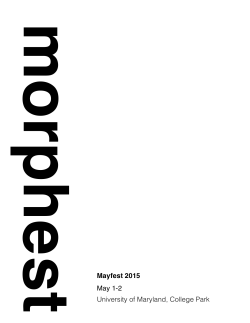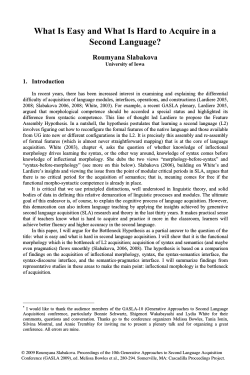
Morpheme
A.Y. 2014/2015 Lingua e traduzione Lingua Inglese I The Structure of English – Exploring and Translating Morphosyntactic Complexity and Creativity Elisa Ghia ghia@unistrasi.it Timetable Corso docente Every Thursday 13.30-15.30, Aula Magna, starting October 9th Office hours (Elisa Ghia) Every Thursday 15.30-16.30, Room 219 Course overview Introduction to the structure of English Introduction to English morphology: the structure and creation of English words ◦ English texts and morphological complexity ◦ Translating morphological complexity and creativity (news texts, web pages, advertisements, technical texts; Receptive tasks [view, analyse and compare translations] and productive tasks [do translation]) English vocabulary: variation in vocabulary selection (varieties of English; register; social variation) ◦ Translating lexical variation Basics in English syntax: phrases, clauses, sentences ◦ Phrase and sentence complexity in text Some questions How are English words constructed? How are new English words created? Why are different words used across different contexts of use of English? Which different English words are used across different contexts? How are English clauses constructed and combined? Which text types tend to contain more complex words? Which types of words are more common in different text types? Which text types tend to contain more complex clauses? How can we translate effectively texts of great morphological or syntactic complexity or using very creative language? Some examples… Picture this. You’ve just uploaded a selfie to your favourite social media website using your phablet when your FIL (that’s your father-inlaw) shares a supercut of a srsly mortifying move. You immediately unlike his page because there isn’t an emoji capable of expressing your desire to vom: apols, but it’s time for a digital detox. Readings (students who attend classes) Katamba, F.., 2009, Chapter 5 «Morphology: Word Structure», in J. Culpeper, F. Katamba, P. Kerswill, R. Wodak, T. McEnery, English Language. Description, Variation and Context, Palgrave MacMillan, Basingstoke: pp. 77-86; 95-97; 101-110). Leech, G., 2009, Chapter 6 «Grammar: Words (and Phrases)» and Chapter 7 «Grammar: Phrases (and Clauses), in J. Culpeper, F. Katamba, P. Kerswill, R. Wodak, T. McEnery, English Language. Description, Variation and Context, Palgrave MacMillan, Basingstoke: pp. 111-117; pp. 130-33. Readings (students who do not attend classes) Katamba, F.., 2009, Chapter 5 «Morphology: Word Structure», in J. Culpeper, F. Katamba, P. Kerswill, R. Wodak,T. McEnery, English Language. Description,Variation and Context, Palgrave MacMillan, Basingstoke: pp. 77-86; 95-97; 101-110. Leech, G., 2009, Chapter 6 «Grammar: Words (and Phrases)», pp. 111-117 and Chapter 7 «Grammar: Phrases (and Clauses), in J. Culpeper, F. Katamba, P. Kerswill, R. Wodak, T. McEnery, English Language. Description,Variation and Context, Palgrave MacMillan, Basingstoke. Jackson, H., Zé Amvela, E., 2007, Words, Meaning and Vocabulary, Continuum, London: pp. 118-125. Taylor, C., Language to Language, OUP, Oxford, 1998, pp. 2629; 36-47; texts: 202-205, 288-297. Outline of today’s class Introduction: Levels of language English morphology: The form and internal structure of English words Main topics in morphology Units in morphology Types of morphemes in English English inflectional morphology Learning about the English language Why study the structure of English Why study English morphology Why study English syntax Why study English vocabulary English morphology, vocabulary and syntax: What they can tell us about texts and speakers/writers Varying grammar, varying aims, varying contexts of language use Translating lexical and morphosyntactic creativity into Italian: What happens crosslinguistically? What it means to study the English language Using English Learning and knowing how English works (metalinguistic knowledge) Developing language awareness (how language works in context) to improve language use and translation skills Language in context CULTURE CONTEXT LANGUAGE Levels of language Levels and ‘chunks’ of text: when we access and produce language; when we translate I’ve been studying English for five years. I’ve been studying English for five years. I / ’ve been studying / English / for five years. I / ’ve / been / studying / English / for / five / years. I / ’ve / be - en / study - ing / Engl - ish / for / five / year - s. Levels of language Phonetics and phonology ◦ The sounds of English Morphology ◦ How English words are constructed Syntax ◦ How English words are combined into phrases, clauses, sentences Semantics ◦ Words, sentences and meaning Pragmatics ◦ Words, sentences and use in context Phonetics and phonology ◦ sheep [‘shi:p] vs. ship [‘ship] Morphology ◦ dogs, hopeless, wireless Syntax ◦ Meet me | in my office | at 10. Semantics ◦ pet, dog, Alsatian Pragmatics ◦ Could I have a drink? / Get me some booze! The rank scale TOPDOWN Text analysis / Pragmatics TEXT / DISCOURSE SENTENCE Meaning Semantics Syntax CLAUSE PHRASE WORDS MORPHEMES GRAPHEMES / PHONEMES BOTTOMUP Morphology Phonology/ phonetics 15 Levels of language, use of English and what they can tell us about a text Word form (morphology) and what it can tell us about specific use of English Vocabulary selection and what it can tell us about specific use of English Syntactic patterns and complexity and what they can tell us about specific use of English The rank scale TEXT / DISCOURSE Text analysis / Pragmatics SENTENCE Meaning Semantics CLAUSE PHRASE WORDS MORPHEMES GRAPHEMES / PHONEMES Syntax Morphology Phonology/ phonetics 17 1. 2. 3. 4. The form of words: My grandmother’s very old and uggy now so we can’t get out much. She gave me my grandfather’s gold watch. I’ll uggy it forever. The poor people lived crowded together in uggies in the old part of the city. They can’t afford to buy meat and fish. They live very uggily on rice and potatoes. What is the meaning of the words in bold in the previous sentences? What enabled you to infer their meaning? ◦ Position and environment of the word in a sentence ◦ Word form The splers contered comfully in backence. What information can you gather from the nonsense words in the sentence? What types of words are the nonsense words (word classes)? How many splers were there? At what point in time is the action set? What types of nouns are spler and backence (countable/uncountable, concrete/abstract)? Why study English morphology Learning about the internal structure of English words ◦ Information about word meaning ◦ Information about word classes and grammatical roles ◦ Accessing different types of English texts Learning how new English words are created ◦ Understanding and applying linguistic creativity ◦ Accessing different types of English texts Morphology Morphology: studying the internal structure of words The rules used to form new words (and segment and analyse existing words) Morphology and its questions wireless What elements does this word consist of? art Can we subdivide it into further parts? luxuriously vs. lyluxurious Are there any rules that determine possible and impossible combinations of elements within words? How can we create new words? Morphology A subdiscipline of linguistics which studies the internal structure of words, the rules regulating such internal structuring, as well as the ways in which new words are created Morphology WIRELESS WIRE LESS It cannot be subdivided into further parts Both elements are meaningful: WIRE = ‘metal drawn out into a thin flexible thread or rod.’ LESS = ‘without’ Morphology: breaking and analysing words into meaningful units Lexemes and morphemes Lexeme: A single vocabulary item or dictionary entry Grammatical word: A lexeme and all of its variants (morphosyntactically related forms) Morpheme: The basic unit in morphology The smallest unit of morphological structure Lexemes and morphemes Lexeme: learn Grammatical word: learn/learns/learning Morpheme: learn-s Lexeme: Grammatical word: Studying the morphology of words – how words are structured and how new words are created. Morphemes: the smallest units of meaning Morphemes are the smallest units of language that have their own meaning or grammatical function within a particular language. A word must consist of at least one morpheme. Think about English morphemes for plural or iteration Morphs vs. morphemes Morpheme – abstract level Morph – concrete level, linguistic realization Allomorphs – same morpheme, different morphs (variants of the same morpheme across different contexts) Allomorphs Derive words from the following items having opposite meaning to them – and containing the original item: possible relevant different active impossible irrelevant indifferent inactive imirin- Different form but same meaning and grammatical function Alternance of context: *inrelevant *inpossible Types of morphemes Based on autonomy Based on position in the word Based on function (inflectional vs. derivational) Types of morphemes I - Autonomy Free morphemes – Content - the elements that convey the bulk of meaning (e.g. charge in recharge) Bound morphemes – Functional - the morphemes that add detail and nuance to the meaning of the content morphemes or that help the content morphemes to fit the grammatical context (e.g. re in recharge) Divide the following words into bound and free morphemes: Treatment What type of Unrecognizable information do Interesting the morphemes Sandy allow you to Friendly gather on the Biggest word? Uselessness Developmental What is the Practicality meaning of these Agree bound and free Blackish morphemes? Divide the following words into bound and free morphemes: fondness What type of coagulative information do deactivators the morphemes allow you to forbearingly gather on the half-deafened word? left-handedness noncombatant What is the readability meaning of these temporarily bound and free weedkiller morphemes? What morphology can tell us about a text Morphology and creativity in advertising. Identify bound and free morphemes in these advertisements: What morphology can tell us about a text Identify bound and free morphemes in the following advertising text: Cartier advertisement “Like some fabulous, legendary jewel box, the Cartier boutique offers treasures of dazzling refinement. Exclusive creations from a celebrated jeweler. Cascades of stunningly inventive objects. From the luxuriously prestigious to the elegantly functional. Everything is extraordinary. Everything tempts. Jewelry, wrist-watches, lighters, writing instruments, leather goods, perfumes, eyewear…the Cartier boutique epitomizes the fine art of living, the fine art of giving.” Compare with Italian
© Copyright 2025















